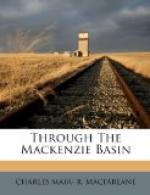That night a concert was improvised on deck, in which the music-hall element came to the front. But one speedily tired of the “Banks of the Wabash,” and other ditties; in fact, we were burning to get to Fort McMurray, where we expected letters and papers from the outer world and home, and nothing else could satisfy us. By evening we had passed Burnt Point, also Poplar Point, where the body of an unfortunate, called Patterson, who had been drowned in one of the rapids above, was recovered in spring by some Indians, the body being completely enclosed in a transparent coffin of ice. On the following day we passed Little Red River, and next morning reached the fort, where, to our infinite joy, we received the longed-for letters and papers—our first correspondence from the far East.
Fort McMurray consisted of a tumble-down cabin and trading-store on the top of a high and steep bank, which had yet been flooded at times, the people seeking shelter on an immense hill which overlooked it. Above an island close by is the discharge of the Clearwater River, the old canoe route by which the supplies for the district used to come, via Isle a la Crosse. At McMurray we left the steamer and took to our own boats, our Commission occupying one, and Mr. Laird and party the other. The trackers got into harness at once, and made very good time for some miles, the current not being too swift just here for fast traveling.
Chapter IX
The Athabasca River Region.
We were now traversing perhaps the most interesting region in all the North. In the neighbourhood of McMurray there are several tar-wells, so called, and there, if a hole is scraped in the bank, it slowly fills in with tar mingled with sand. This is separated by boiling, and is used, in its native state, for gumming canoes and boats. Farther up are immense towering banks, the tar oozing at every pore, and underlaid by great overlapping dykes of disintegrated limestone, alternating with lofty clay exposures, crowned with poplar, spruce and pine. On the 15th we were still following the right bank, and, anon, past giant clay escarpments along it, everywhere streaked with oozing tar, and smelling like an old ship.
These tar cliffs are here hundreds of feet high, of a bold and impressive grandeur, and crowned with firs which seem dwarfed to the passer-by. The impregnated clay appears to be constantly falling off the almost sheer face of the slate-brown cliffs, in great sheets, which plunge into the river’s edge in broken masses. The opposite river bank is much more depressed, and is clothed with dense forest.




